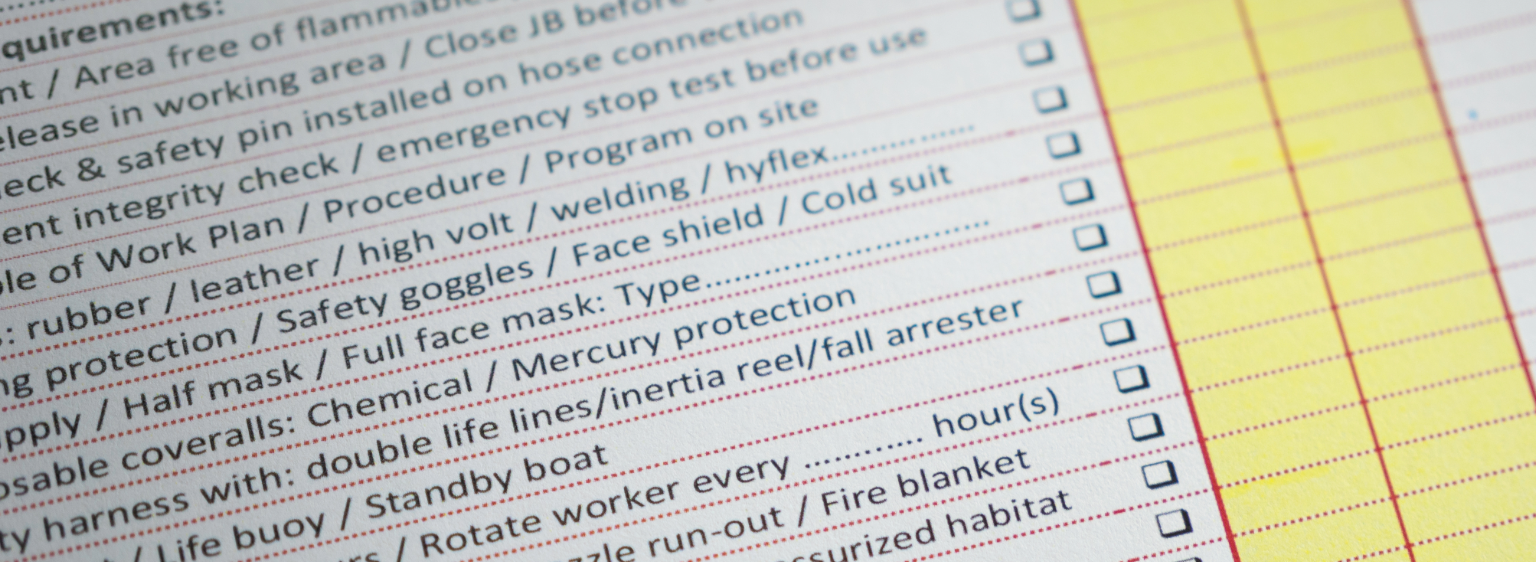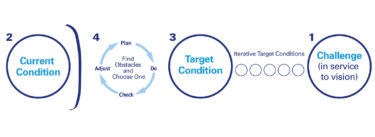Funny you should ask that. I’ve struggled with the same question for years. In one company I remember, we asked an unfortunate lean officer to go out there and “write standards”. He was (is) a good guy, and he read the books about what standards really look like – I highly recommend Jeff and David’s Toyota Talent – and then he went at it, writing a “work standards” document for each workstation, complete with photos and all. The poor guy kept at it for almost two years and, as a complete idiot, I kept arguing he should plod on as “it would all come in useful some time.” In the end, he came close to burnout and we never did use all his hard work – I’m still contrite and embarrassed about the whole episode (and relieved this is one of the lucky cases where the guy recovered and went on to do great work afterwards).
After this awkward episode, once burned twice shy, I kind of avoided the topic, but the inevitability of it came back all the time. My sensei kept insisting, as you mention, that there can’t be kaizen without standards. The good thing about lean (i.e., the annoying thing about lean) is that you don’t choose your learning topics, so I took a deep breath and tried to take a step back to look at the topic differently. I’ve found that, when in doubt, with lean ideas that don’t quite square, start from putting yourself in the operator’s shoes and looking through their eyes.
Eight Hours of Standardized Work
What can really ruin an operator’s day? Whether on the production floor or at any sales point, visualize the person that feels they’re doing their best to do a good job every day and then they get yelled on by a customer or blamed by their supervisor for doing bad work. This is particularly painful because it is perceived as both unfair (they try hard every day in what they feel are difficult circumstances) and destabilizing because of the nagging doubt that, indeed, they might be doing the job wrong. No amount of self justification (I’m doing what I can) or rationalization (It can’t be that bad) can compensate for the anxiety created by the fear of your boss developing a bad (wrong?) impression of you. This is really, really bad.
The other point that gave me pause was one of my senseis’ insistence that the role of the supervisor was to give eight hours of standardized work to every operator – not just work standards, but standardized work! I never could connect with that because most working environments I know, from manufacturing to service, what supervisors really do is shift people around from one station to the other and tell them what to do when, not how to do it, let alone, how to do it at takt time in the correct sequence of movements. My sensei’s points were that:
- A worker should only perform standardized work during his/her working day
- The manager should give him/her eight hours of standardized work to perform
- When the standardized work is finished the person should stop working
- Any non-standardized work should be examined and questioned:
- Is it necessary work?
- If so, should this operator be doing it?
His point was that management’s responsibility was to progressively eliminate non-standardized work from the shop floor – quite a challenge.
Another aspect of the conundrum was that in any Toyota plant across the world, the routine emphasis on on-the-job training is obvious, but here we’re back to the puzzle. Since there are work standards for everything in the Toyota environment, TWI training techniques can be applied – but what do you do when there are no standards? Back to the chicken and egg problem.
Well having failed at first tackling the standards side of the puzzle, I wondered why not start from the other side. In the very same factory where we had burned one guy at writing work standards, we asked the supervisor to train operators every day – the rule was one day, one operator, 20 minutes training. The supervisor ran about thirty guys, so this meant he should see every person for 20 minutes every two months or so. We set up a visual plan on a white board so that every operator could see when they’d be trained, and off we went.
At first, the supervisor tried to use the detailed work standards that had been compiled, but this simply didn’t do. Either the operator was an experienced veteran and he’d scoff at the procedure that didn’t tell him anything he needed to know, or the operator was a newbie and then the elaborate documents were far too detailed to use in twenty minutes. Aaargh! After a couple of months, we decided to abandon the documents and focus on the training relationship. The supervisor would have to work pen on paper to write an A4 page (no more than an A4 – this turned out to be important) as a checklist to do the job right. In the end, this check list ended up including:
- List the main steps to do the work
- OK versus NOK descriptions at key points
- Safety reminders
Which looks pretty much like what a classic operations work standard sheet should look like! It turned out that during the 20 minute discussions, the supervisor checked the main sequence with the inexperienced operators and whether they understood the hard parts, and would refine the OK/NOK descriptions with the veterans. To my complete surprise (and relief), folders of standard work sheets started appearing at workstations (high-mix environment), and lots of new, technical kaizen opportunities started coming up from discussions with operators. Even more surprising, a better mastery of operation standards let to discussing standardized work: the actual movements of the operator in the cell: feet, hands, eyes.
The next thing I know, I’m working in the service operation of a company with the dispatchers that tell the maintenance technician where to drive to repair what. After visualizing the first key indicators (trips with the wrong information, customer lead-time etc.) we initiate a training program in the same format. What we discover is that contracts vary from customer to customer and it’s incredibly hard for the dispatcher to know exactly what is owed for what customer. So they start establishing standards by contract type, and now they discover they need to investigate more thoroughly with the customer on the phone before dispatching a technician. In this case, they started with existing procedures, and through the 20 minutes per day system, turned these general procedures into specific work standards.
In both cases, as is described in Toyota Talent, we discover that very few key movements make the bulk of the work (in the maintenance case, three main parts make 80% of the changes). We then set up a “dojo,” a special area where technicians come back and are trained every day, not at the special cases, but at becoming extremely good at what they do everyday – with a remainder about safety on the station. With this system, the dispatching center now has a regular, technical discussion with each technician in turn – the kaizen wheel starts again. How far can we go with this? In one engineering company, the engineering head has started a row of black folders with “checklists” that he examines in the same 20 minutes a day with the engineers he manages. These checklists range from product OK/NOK to how to use the CAD programs.
The Key to Standard Work
The answer to your question, I now believe, lies not in the standard work per se, but in tasking managers with improving operators’ confidence in their own OK/NOK judgment. More than a decade ago as I was first trying to figure out the engineering part of lean, I was repeatedly struck with Toyota veteran’s insistence that no solution should be sought to problems unless the test method for that solution was formulated first. It took me more than 10 years to see how that can be operationalized at a work level, but I’m now confident that the relationship between supervisor and worker is key to establishing standard work.
As for kaizen, well, surprisingly, in the workplaces I know now that using this approach to constantly train to standards (and the on-going evolution of standard documents as tools to support operator OK/NOK judgment), kaizen topics have changed in nature and are less process-driven and far more technically focused. As a result, kaizen is much, much richer in know-how lessons. Improvements are more people-centric, and less to do about organization, and, looking back have much wider reaching impacts on work, products and customer satisfaction.
I don’t know if this helps in your specific situation, as it can be a hard sell – it radically changes the nature of the supervisory job. In my case, I have the good fortune of working with the senior management of companies, so when they’re convinced, things usually tend to happen. In any other case, bear in mind that although such a shift in approach clearly benefits operators, it’s also a huge challenge to frontline management, and they need serious help to achieve it. On the other hand, this approach can unlock the most unlikely environments. One senior manager I know at the Post Office has started asking systematically for “dojos” in his area, and the results have been spectacular, with several thousand “dojos” up and running and stunning rises in employee satisfaction numbers. In this specific case they have formulated the purpose of their lean approach as “supporting professional gestures.” Wow.
Building a Lean Operating and Management System
Gain the in-depth understanding of lean principles, thinking, and practices.







An extremely candid take on why and how of Standard Work. A wonderful read.